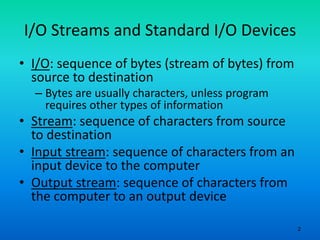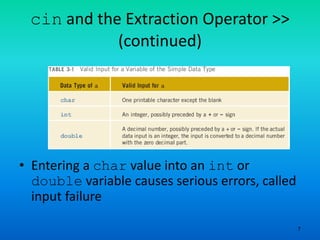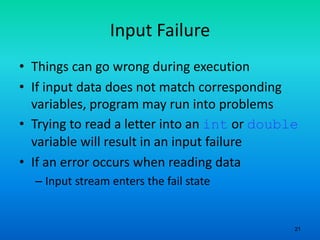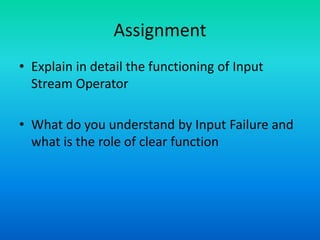Object oriented programming 13 input stream and devices in cpp
- 1. Object Oriented Programming: 13 Input Stream /Extraction Operator Prof Neeraj Bhargava Vaibhav Khanna Department of Computer Science School of Engineering and Systems Sciences Maharshi Dayanand Saraswati University Ajmer
- 2. 2 I/O Streams and Standard I/O Devices • I/O: sequence of bytes (stream of bytes) from source to destination – Bytes are usually characters, unless program requires other types of information • Stream: sequence of characters from source to destination • Input stream: sequence of characters from an input device to the computer • Output stream: sequence of characters from the computer to an output device
- 3. 3 I/O Streams and Standard I/O Devices (continued) • Use iostream header file to extract (receive) data from keyboard and send output to the screen – Contains definitions of two data types: • istream - input stream • ostream - output stream – Has two variables: • cin - stands for common input • cout - stands for common output
- 4. 4 I/O Streams and Standard I/O Devices (continued) • To use cin and cout, the preprocessor directive#include <iostream> must be used • Variable declaration is similar to: – istream cin; – ostream cout; • Input stream variables: type istream • Output stream variables: type ostream
- 5. 5 cin and the Extraction Operator >> • The syntax of an input statement using cin and the extraction operator >> is: • The extraction operator >> is binary – Left-side operand is an input stream variable • Example: cin – Right-side operand is a variable
- 6. 6 cin and the Extraction Operator >> (continued) • No difference between a single cin with multiple variables and multiple cin statements with one variable • When scanning, >> skips all whitespace – Blanks and certain nonprintable characters • >> distinguishes between character 2 and number 2 by the right-side operand of >> – If type char or int (or double), the 2 is treated as a character or as a number 2
- 7. 7 cin and the Extraction Operator >> (continued) • Entering a char value into an int or double variable causes serious errors, called input failure
- 8. 8 cin and the Extraction Operator >> (continued) • When reading data into a char variable – >> skips leading whitespace, finds and stores only the next character – Reading stops after a single character • To read data into an int or double variable – >> skips leading whitespace, reads + or - sign (if any), reads the digits (including decimal) – Reading stops on whitespace non-digit character
- 9. 9 cin and the Extraction Operator >> (continued)
- 11. 11 Using Predefined Functions in a Program • Function (subprogram): set of instructions – When activated, it accomplishes a task • main executes when a program is run • Other functions execute only when called • C++ includes a wealth of functions – Predefined functions are organized as a collection of libraries called header files
- 12. 12 Using Predefined Functions in a Program (continued) • Header file may contain several functions • To use a predefined function, you need the name of the appropriate header file – You also need to know: • Function name • Number of parameters required • Type of each parameter • What the function is going to do
- 13. 13 Using Predefined Functions in a Program (continued) • To use pow (power), include cmath – Two numeric parameters – Syntax: pow(x,y) = xy • x and y are the arguments or parameters – In pow(2,3), the parameters are 2 and 3
- 15. 15 Using Predefined Functions in a Program (continued) Sample Run: Line 1: 2 to the power of 6 = 64 Line 4: 12.5 to the power of 3 = 1953.13 Line 5: Square root of 24 = 4.89898 Line 7: u = 181.019 Line 9: Length of str = 20
- 16. 16 cin and the get Function • The get function – Inputs next character (including whitespace) – Stores in memory location indicated by its argument • The syntax of cin and the get function: varChar – Is a char variable – Is the argument (parameter) of the function
- 17. 17 cin and the ignore Function • ignore: discards a portion of the input • The syntax to use the function ignore is: intExp is an integer expression chExp is a char expression • If intExp is a value m, the statement says to ignore the next m characters or all characters until the character specified by chExp
- 18. 18 putback and peek Functions • putback function – Places previous character extracted by the get function from an input stream back to that stream • peek function – Returns next character from the input stream – Does not remove the character from that stream
- 19. 19 putback and peek Functions (continued) • The syntax for putback: – istreamVar: an input stream variable (cin) – ch is a char variable • The syntax for peek: – istreamVar: an input stream variable (cin) – ch is a char variable
- 20. 20 The Dot Notation Between I/O Stream Variables and I/O Functions • In the statement cin.get(ch); cin and get are two separate identifiers separated by a dot • Dot separates the input stream variable name from the member, or function, name • In C++, dot is the member access operator
- 21. 21 Input Failure • Things can go wrong during execution • If input data does not match corresponding variables, program may run into problems • Trying to read a letter into an int or double variable will result in an input failure • If an error occurs when reading data – Input stream enters the fail state
- 22. 22 The clear Function • Once in a fail state, all further I/O statements using that stream are ignored • The program continues to execute with whatever values are stored in variables – This causes incorrect results • The clear function restores input stream to a working state
- 23. Assignment • Explain in detail the functioning of Input Stream Operator • What do you understand by Input Failure and what is the role of clear function






















